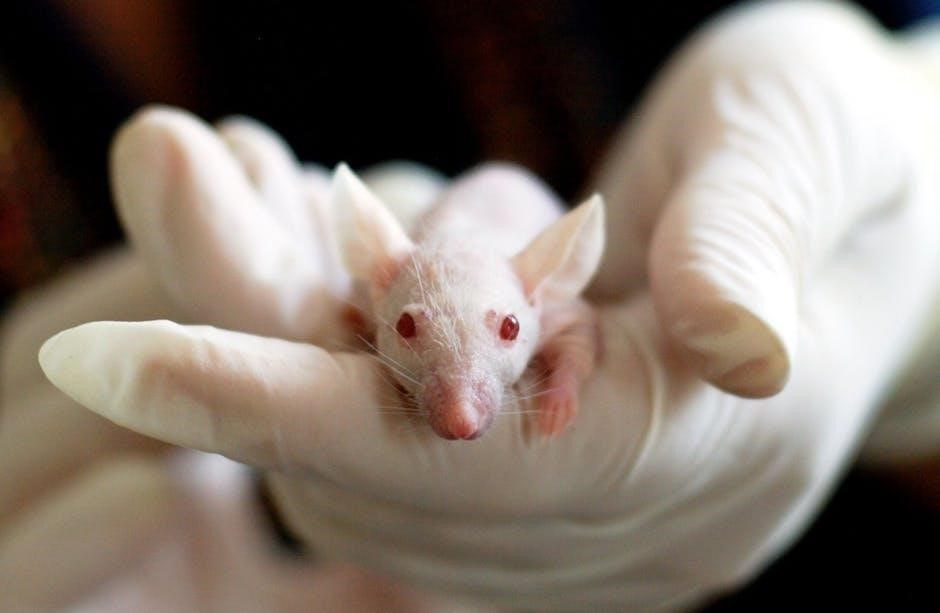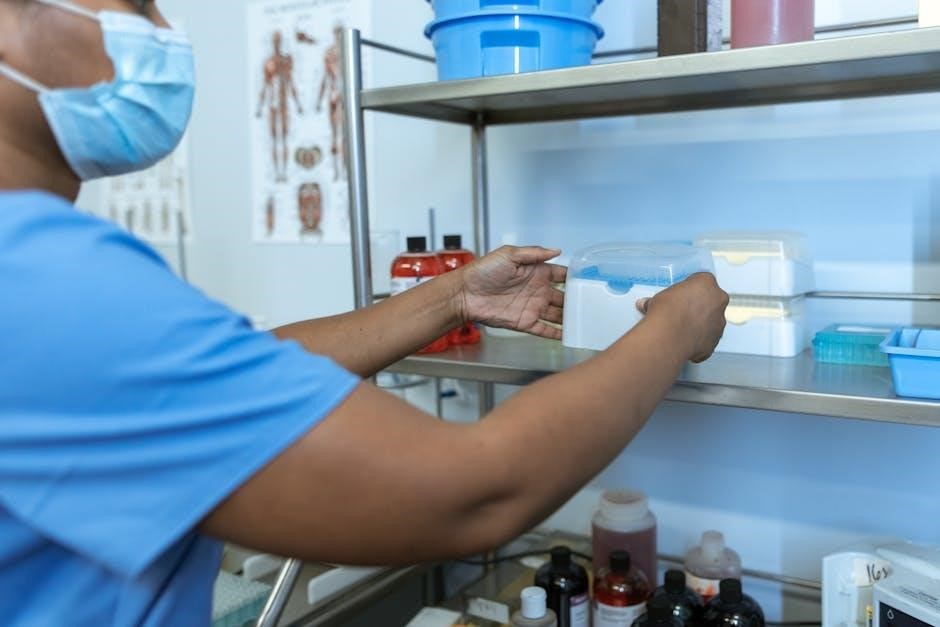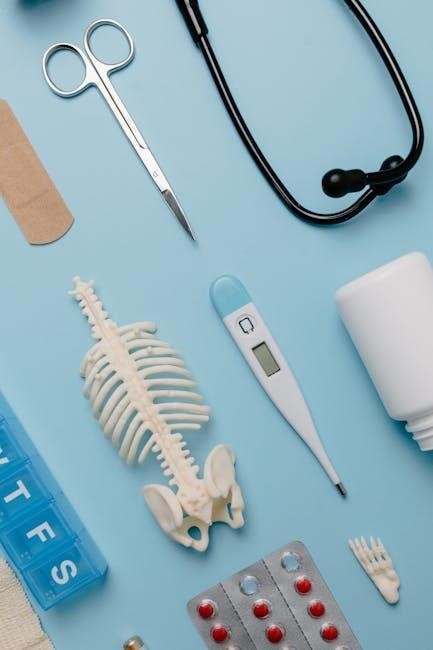The Anatomy and Physiology laboratory provides a fundamental, hands-on experience, enabling students to explore anatomical structures and physiological processes through practical exercises and digital tools, enhancing their understanding of human biology․
1․1 Importance of Laboratory Work in Understanding Anatomy and Physiology
Laboratory work is essential for understanding anatomy and physiology, offering hands-on experience and practical application of theoretical knowledge․ Through dissection, experiments, and interactive models, students gain a deeper understanding of anatomical structures and physiological processes․ This experiential learning enhances critical thinking and prepares students for real-world clinical applications, making it a cornerstone of anatomy and physiology education․
1․2 Overview of Laboratory Safety and Etiquette
Laboratory safety and etiquette are crucial to ensure a secure and respectful learning environment․ Students must adhere to safety protocols, such as wearing personal protective equipment (PPE) and properly handling biological specimens․ Maintaining a clean workspace, following disposal guidelines, and respecting shared equipment are essential․ Etiquette involves collaboration, minimizing disruptions, and treating fellow students and instructors with professionalism, fostering a productive and safe atmosphere for all participants․

Anatomical Terminology and Basic Concepts
Anatomical terminology forms the foundation of anatomy and physiology studies, providing a standardized language to describe body structures, directions, and planes․ It ensures clear communication and precise identification of anatomical features and their spatial relationships, enabling effective learning and application in laboratory settings․
2․1 Understanding Anatomical Directions and Planes
Anatomical directions and planes are essential for accurately describing body structures․ Terms like anterior, posterior, superficial, and deep help localize structures․ The sagittal, frontal, and transverse planes divide the body into sections, aiding in precise dissection and visualization․ Mastering these concepts is crucial for identifying and correlating structures in laboratory exercises, ensuring a strong foundation in anatomy and physiology studies․
2․2 Histology: The Study of Tissues
Histology involves the microscopic examination of tissues to understand their structure and function․ Four primary tissue types—epithelial, connective, muscle, and nervous—are studied in the lab․ Laboratory exercises include slide preparation, staining, and microscopy to identify cellular features and tissue organization․ This knowledge is vital for correlating tissue structure with physiological functions and understanding disease mechanisms at the cellular level․
Body Systems Overview
The laboratory manual explores the organ systems, such as digestive, respiratory, cardiovascular, and nervous, focusing on their functions, interconnections, and roles in maintaining homeostasis through hands-on activities․
3․1 Skeletal and Muscular Systems
The laboratory manual focuses on the skeletal and muscular systems, providing detailed exercises for identifying and analyzing bones, muscles, tendons, and ligaments․ Through dissection of fetal pig specimens and 3D models, students explore how these systems contribute to movement and support․ Interactive software enhances understanding of muscle contractions and joint mechanics, correlating anatomical structures with their physiological functions in real-world scenarios․
3․2 Nervous and Endocrine Systems
The laboratory manual explores the nervous and endocrine systems, focusing on their roles in regulation and communication․ Activities include identifying neurons, glands, and hormones through histological slides and 3D models․ Students analyze reflex arcs and hormone secretion, correlating anatomical structures with physiological functions, such as nerve impulse transmission and hormonal balance, using interactive simulations to reinforce complex concepts in human physiology․
Laboratory Exercises and Dissection
Laboratory exercises and dissection provide hands-on exploration of anatomical structures, enabling students to identify organs and tissues, enhancing their understanding of human anatomy and physiology through practical observation and analysis․
4․1 Dissection of Animal Specimens (e․g․, Fetal Pig)
Dissection of animal specimens, such as fetal pigs, is a cornerstone of anatomy and physiology labs, allowing students to explore structural and functional relationships․ This hands-on experience provides a detailed understanding of organ systems, enabling direct observation of anatomical features․ Proper dissection techniques, safety protocols, and correlation with human anatomy are emphasized, fostering a vivid learning experience that bridges theoretical knowledge with practical application․
4․2 Identifying Organs and Structures
Identifying organs and structures is a critical skill in anatomy and physiology labs, requiring careful observation and comparison with anatomical diagrams․ Students learn to distinguish between various tissues, organs, and systems, enhancing their understanding of functional relationships․ This process involves systematic examination, correlation with human anatomy, and the use of tools like magnification and 3D models to ensure accurate identification and comprehension of complex anatomical features․

Physiology Experiments
Physiology experiments involve measuring vital signs, such as heart rate and blood pressure, and conducting simulations to explore complex physiological processes, enhancing practical understanding of bodily functions․
5․1 Measuring Physiological Parameters (e․g․, Heart Rate, Blood Pressure)
Measuring physiological parameters, such as heart rate and blood pressure, provides insights into the body’s functional state․ Students use tools like stethoscopes and sphygmomanometers to collect data, analyzing how these metrics reflect health and disease․ Such exercises bridge theoretical knowledge with practical application, enhancing understanding of cardiovascular physiology and its clinical relevance in real-world scenarios․
5․2 Simulations and Interactive Models
Simulations and interactive models provide engaging ways to explore complex physiological processes․ Digital tools, such as 3D animations and virtual dissections, allow students to visualize and interact with structures like the heart and nervous system․ These resources enhance understanding of dynamic processes, such as blood circulation and neural signaling, making abstract concepts more accessible and fostering deeper learning through interactive exploration․

Clinical Applications of Anatomy and Physiology
Understanding anatomy and physiology is crucial for diagnosing and treating diseases, enabling healthcare professionals to correlate lab findings with clinical scenarios and improve patient care outcomes effectively․
6․1 Case Studies in Anatomy and Physiology
Case studies provide real-world scenarios, enabling students to analyze medical conditions, anatomical abnormalities, and physiological changes․ By identifying structures and correlating lab findings with clinical diagnoses, students gain practical insights into diseases and treatments, enhancing their ability to apply theoretical knowledge in professional healthcare settings effectively․
6․2 Correlating Lab Findings with Real-World Scenarios
Lab findings are linked to real-world medical scenarios, enabling students to understand the practical implications of anatomical and physiological data․ By analyzing clinical cases, students can interpret how lab results, such as organ function or tissue structure, correlate with diagnoses, treatments, and prognoses, bridging the gap between theoretical learning and practical healthcare applications․
Visual Aids and Digital Tools
Visual aids like 3D models and interactive software enhance understanding of anatomical structures and physiological processes, while photography and documentation tools help record and analyze lab findings effectively․
7․1 Using 3D Models and Interactive Software
3D models and interactive software revolutionize anatomy and physiology learning by allowing students to visualize complex structures and processes in detail․ These tools enable virtual dissections, interactive simulations, and real-time exploration of physiological functions, making abstract concepts more tangible and engaging․ They also provide self-paced learning opportunities, enhancing retention and understanding of anatomical and physiological principles․
7․2 Photography and Documentation of Lab Work
Photography and documentation are essential for recording lab observations and experiments․ High-quality images capture detailed anatomical structures, while notes and diagrams provide context․ Proper documentation ensures clarity and organization, aiding in future reference or presentations․ These practices also promote accountability and professionalism in laboratory settings, preserving valuable data for educational and research purposes effectively․
Assessment and Review
Assessment involves quizzes, exams, and lab reports to evaluate understanding․ Regular reviews reinforce concepts, ensuring retention and preparation for practical exams and real-world applications in anatomy and physiology․
8․1 Quizzes and Practical Exams
Quizzes and practical exams assess understanding of anatomical structures and physiological concepts․ Students identify specimens, label diagrams, and demonstrate dissection skills․ Digital simulations are also used for assessment․ These evaluations ensure comprehension and application of laboratory manual content, fostering critical thinking and practical proficiency in anatomy and physiology․
8․2 Lab Reports and Presentation Techniques
Lab reports and presentations are essential for communicating findings effectively․ Students learn to document observations, analyze data, and present results clearly․ The manual provides templates and guidelines for structured reporting and engaging presentations, ensuring accuracy and professionalism․ These skills are vital for academic and professional success in anatomy and physiology․

Additional Resources and References
Recommended textbooks, online platforms, and a glossary of key terms provide additional support for students studying anatomy and physiology, enhancing their understanding and practical application․
9․1 Recommended Textbooks and Online Platforms
Key resources include Laboratory Manual for Human Anatomy & Physiology and Visual Anatomy & Physiology Lab Manual․ Online platforms like Mastering A&P and Visible Body offer interactive tools, while eTextbooks provide flexible access․ These materials support comprehensive learning with detailed diagrams, simulations, and practice exercises, catering to diverse student needs and learning styles․
9․2 Glossary of Key Terms
A glossary is essential for understanding anatomy and physiology terminology․ Key terms include anatomical structures, physiological processes, histology, and tissues․ Definitions cover organs, systems, and homeostasis․ Terms like nervous system, endocrine system, skeletal system, and muscular system are explained․ This section provides clear, concise definitions to aid in mastering complex biological concepts․
